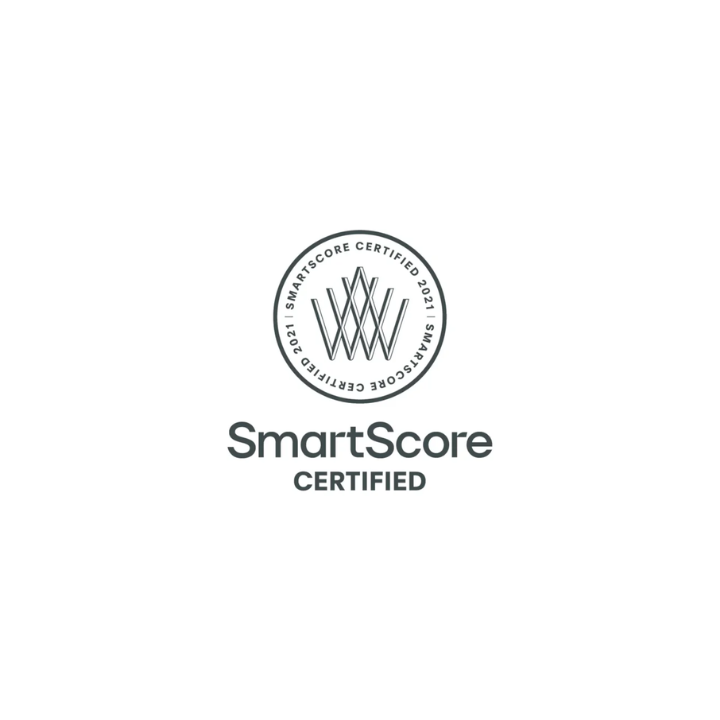SmartScore criteria
The SmartScore certification is divided into two areas, each with six categories, which are considered for the classification of a project:
- (User) functionality of the building (use cases) (67 credits) Evaluation of the implemented user requirements.
- Technical requirements (33 credits) Evaluation of the supporting technologies that enable the implementation of smart use cases.
In the user functionality area, the number of credits that can be earned per category is capped. This means that there are more criteria available in each category than the total number of credits that can be earned. Not every criterion has to be fulfilled in order to receive the full number of points in a category. This approach leaves room for the individuality of each project. In addition, up to 5 credits are awarded for particularly innovative measures that go beyond the SmartScore requirements. There are two ways to earn the additional points:
- Implementation of a new functionality that is not mapped in the user functionality area of the building and makes a significant positive contribution to creating a sustainable, cost-efficient and future-proof building.
- Implementation of a technical innovation that goes beyond the technical requirements and contributes to making building technology future-proof.
In order to receive the credits for particularly innovative measures, an additional application form must be completed and submitted together with the relevant supporting documents.
The functionality (user functionality) of a smart building is evaluated in the following categories:
- UF1: Individual and collective productivity
- UF1:1 Arrival of visitors
- UF1:2 Visitor check-in
- UF1:3 Routing
- UF1:4 Booking meeting rooms
- UF1:5 Localization of persons
- UF2: Health and well-being
- UF2:1 Air quality
- UF2:2 Disease prevention (contact tracing)
- UF2:3 Disease prevention (distance)
- UF2:4 Well-being Reporting
- UF2:5 Individual adaptation of the working environment
- UF2:6 Cleanliness of the building
- UF3: Sustainability
- UF3:1 Energy consumption
- UF3:2 Breakdown of energy sources
- UF3:3 Water consumption
- UF3:4 Optimization of building use
- UF3:5 Self-optimization of systems
- UF3:6 Waste management
- UF3:7 E-mobility charging stations
- UF4: Community and services
- UF4:1 Provision of and access to building services
- UF4:2 Provision of and access to external service providers
- UF4:3 Access to environmental information
- UF4:4 Delivery services
- UF4:5 Booking of additional amenities
- UF4:6 Recording feedback
- UF5: Maintenance and operation
- UF5:1 Land use
- UF5:2 Reports on maintenance costs
- UF5:3 Warnings in the event of system errors
- UF5:4 Problem tracking system
- UF5:5 Self-diagnosis of faults
- UF5:6 Predictive maintenance
- UF5:7 Optimization of elevator control
- UF6: Security
- UF6:1 Building access
- UF6:2 Building security
- UF6:3 Building occupancy
- UF6:4 Compliance with the house rules
- UF6:5 Fire alarm
- UF6:6 Access for third parties
The technological foundation of a smart building is assessed in the following categories:
- TF1: Digital connectivity for tenants
- TF1:1 Diversity of cable routes for tenants
- TF1:2 Selection of fiber optic and microwave providers
- TF1:3 WLAN connection for users in common areas
- TF2: Building systems
- TF2:1 Technical equipment register (TGA)
- TF2:2 Operational platform for central systems engineering
- TF2:3 Operational platform: Integration of the extended system technology
- TF2:4 Software platform for building users
- TF2:5 Software interfaces for smart integration
- TF2:6 Software platform for operation and maintenance
- TF3: Integration Network on the landlord side
- TF3:1 Integration Network space requirements
- TF3:2 Passive network infrastructure
- TF3:3 Active network infrastructure
- TF3:4 Internet supply of the system technology
- TF3:5 WLAN network of the system technology
- TF3:6 ‘Integration Network’ supports additional systems
- TF4: Governance
- TF4:1 Smart building strategy
- TF4:2 Smart integration guide for tenants
- TF4:3 Effectiveness of smart functionalities
- TF5: Cyber Security
- TF5:1 Policy for Cyber Security
- TF5:2 Implementation of the Cyber Security Directive
- TF5:3 Proactive cyber security tests
- TF6: Data exchange
- TF6:1 Policy for the handling of user data
- TF6:2 Aggregation of building data
SmartScore certification levels:
In the SmartScore certification, 5 levels can be achieved, each based on an internationally standardized combination of a scoring model and various minimum criteria for each certification level
-
Not Certified
-
SmartScore Certified
- (min. 45/100 credits): Credits in at least three categories from the area of user functionality and fulfilment of a specified technical requirement (TF 1:2)
-
SmartScore Silver
- (min. 63/100 credits): Credits in at least four categories from the area of user functionality and fulfilment of four defined technical requirements (TF 1:2, 2:1, 3:1, 3:2)
-
SmartScore Gold
- (min. 77/100 credits): Credits in at least five categories from the area of user functionality and fulfilment of seven specified technical requirements (TF 1:2, 2:1, 2:3, 3:1, 3:2, 4:1, 5:1)
-
SmartScore Platinum
- (min. 90/100 credits): Credits in all categories from the area of user functionality and fulfilment of ten specified technical requirements (TF 1:1, 1:2, 2:1, 2:3, 2:5, 3:1, 3:2, 4:1, 5:1, 6:3)

- (min. 90/100 credits): Credits in all categories from the area of user functionality and fulfilment of ten specified technical requirements (TF 1:1, 1:2, 2:1, 2:3, 2:5, 3:1, 3:2, 4:1, 5:1, 6:3)
We are happy to support you with your SmartScore certification! Get in touch with us!
Phone +49 711 62049-340 Email info@hoinka.com



